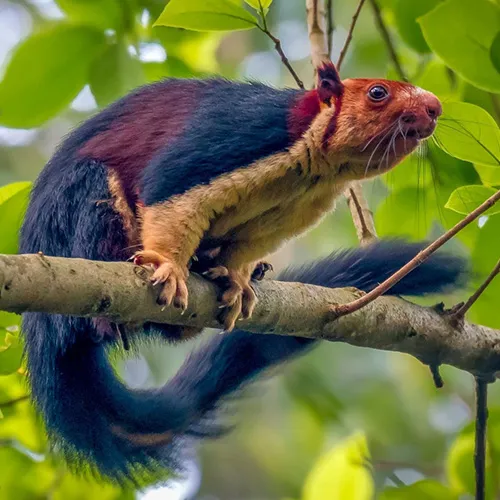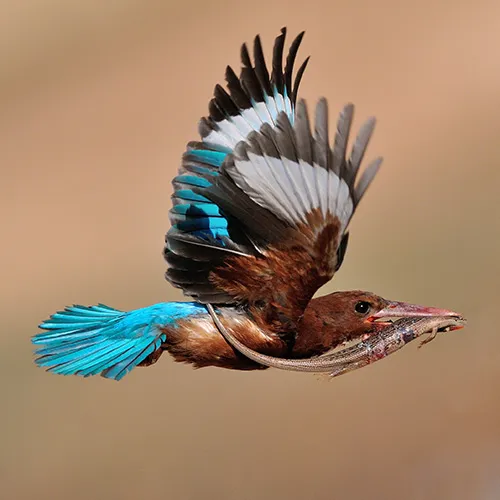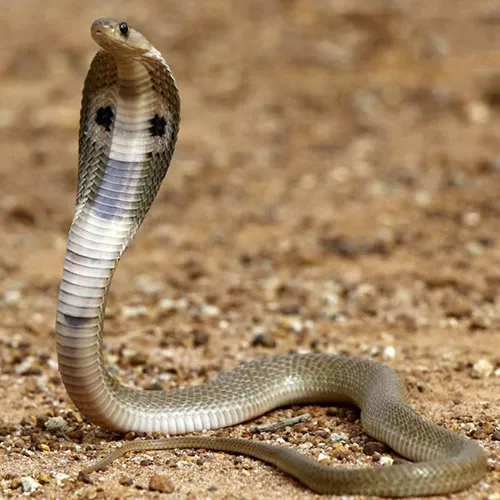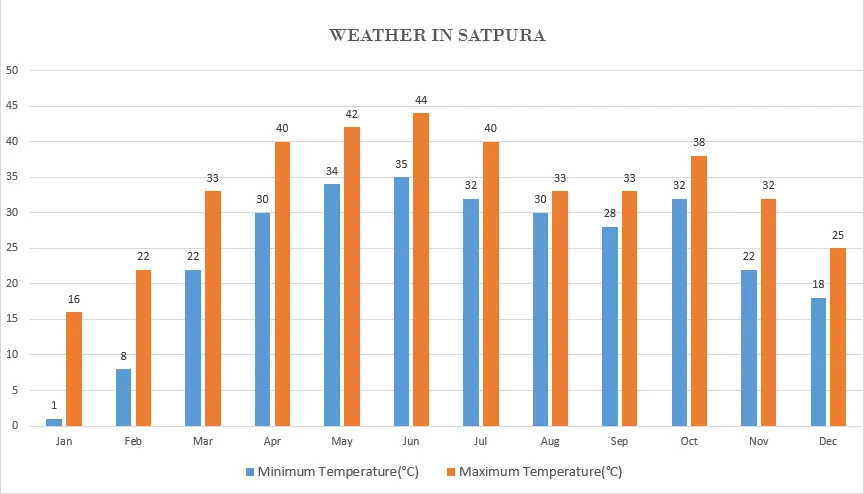Satpura National Park
Madhya Pradesh, India
About Satpura National Park
Satpura National Park, nestled in the heart of the Central Indian Highlands, is a haven for wildlife enthusiasts and adventure seekers. With its diverse ecosystems and captivating landscapes, it has become a prime destination for nature safaris in India. For those eager to experience the thrill of tiger safaris in India, Satpura stands out as a remarkable choice.
The park’s rich biodiversity extends beyond the elusive tigers that roam its expanses. Visitors can revel in the excitement of spotting majestic leopards, observing the playful antics of sloth bears, and immersing themselves in the vibrant birdwatching opportunities that this natural paradise offers.
Embarking on a tiger safari in Satpura is a unique experience. Initially cautious towards jeep vehicles when tourism began in 2008, the tigers have since grown accustomed to human presence, providing enthusiasts with increased chances of sightings. The park’s commitment to conservation has led to a notable rise in tiger populations by 2018.
Nature safari enthusiasts will find Satpura to be more than just a conventional wildlife destination. In addition to the standard jungle safaris, the park offers a variety of activities, including boat safaris and canoe expeditions along the Denwa River. Walking safaris allow visitors to intimately connect with the surroundings, enhancing the overall wilderness adventure.
For those seeking an immersive experience, camping along the river for two nights and three days is an option that adds an extra layer of excitement to the journey. The period until March is ideal for boat safaris when the Denwa River’s water level is at its best, providing a picturesque backdrop to the safari experience.
Satpura National Park is not just about wildlife; it’s a gateway to a holistic adventure. Churna Camp, located within the park, offers a genuine forest experience for those who wish to stay within the national park’s bounds. The park’s commitment to diverse activities sets it apart, making it a premier destination for travelers seeking an all-encompassing wilderness adventure.
Moreover, Satpura’s proximity to Pachmarhi, the highest point in the Central Indian Highlands, adds another layer to the adventure. A two-hour drive takes you to Pachmarhi, where the Bison Lodge, originally constructed by Captain James Forsyth, has been transformed into an interpretation center. Dhupgarh, the summit of the hill, is renowned as the sunrise point, offering breathtaking views.
For travelers interested in combining their wildlife adventure with cultural exploration, Satpura provides an excellent gateway to tiger and culture tours. Additionally, its strategic location allows for convenient extensions to other iconic destinations, such as the Taj Mahal. Nature safari in India takes on a new dimension in Satpura, where every moment is an opportunity to connect with the wild and appreciate the beauty of the natural world.
Highlights
- Rich wildlife diversity with elusive tiger sightings
- Sloth bears and leopards offer captivating encounters.
- Varied activities including boat, canoe, and walking safaris
- Unique river camping experience for 2 nights and 3 days.
- Tigers adapting to tourism since 2008, increasing in numbers.
- Churna Camp provides an immersive forest stay option.
- Abundant activities set it apart from other parks.
- Nearby Pachmarhi hill station and historic Bison Lodge interpretation.
Facts about Satpura National Park
Area: 2133.3 sq. km- 1340 sq. km is core and 794 sq. km is buffer forest.
Coordinates: Latitude: 22’19” to 22’45’ N , Longitude: 77’53” to 78’34’”E.
Key Species of Satpura National Park

Mammals
- Tiger
- Leopard
- Indian Giant Squirrel
- Sloth Bear
- Wild Dogs
- Four Horned Antelope
- Gaur
- Rusty Spotted Cat
- Malabar Tree Shrew
- Sambar Deer

Birds
- Malabar Pied Hornbill
- Scarlet Minivet
- Indian Paradise Flycatcher
- Sirkeer Malkoha
- Osprey
- Indian Eagle Owl
- Indian Skimmer
- Black Bellied Tern
- Malabar Whistling Thrush
- Bonelli’s Eagle

Reptiles
- Mugger Crocodile
- Monitor Lizard
- Indian Rock Python
- Spectacled Cobra
- Saw Scaled Viper
- Indian Flapshell Turtle
- Bronzeback Tree Snake
- Green Keelback
- Common Cat Snake
- Common Krait
Safari Zones of Satpura National Park
Each park is divided into three types of zones: Core, Buffer, and Reserved. The Core zone serves as the protected heart of the jungle, preserving the natural state of the ecosystems within the biosphere reserves. The forest department strictly safeguards wildlife and natural resources in this area. The Buffer zone is a harmonious coexistence of animals and a portion of the human population. Finally, the Reserved forest acts as a virtual boundary for the entire forest. However, it’s important to note that animals in the forest are unaware of these zones and freely roam throughout their home.
Madhai: Madhai boasts a diverse landscape, providing a tranquil experience whether you explore the park by jeep, on foot, or by canoe. The terrain features rolling basalt and sandstone hills, a meadow bustling with deer, wild pigs, peafowl, and langurs, mixed forests where Giant squirrels gracefully hop from branch to branch, numerous waterholes, and the river Sonbadra meandering through, attracting an impressive array of reptiles and birds.
Panaarpaani (Pachmarhi): The entrance to Panaarpaani, located in the Mahadeo Hills of the Pachmarhi Biosphere and newly opened in 2019, offers a rich and lush environment. The dense foliage is filled with fruiting trees and medicinal plants, which draw in a variety of birds, butterflies, Sloth Bears, Indian Giant Squirrels, and more. It’s an excellent spot for birdwatching, with the possibility of spotting the Black Crested Bulbul and the Malabar Whistling Thrush along the way.
Reaching Satpura National Park
Train
Itarsi Railway Junction is a major train station where most trains from cities like Delhi, Mumbai, Pune, Jabalpur and Bangalore comply. It is about 70 Km which is 1 Hour 30 Minutes away from the National Park.
Flight
Bhopal Airport is the closest to the national park at a distance of 180 Km which takes around 3 Hr 30 Minutes away. The airport is well connected with flights from Delhi, Mumbai, Bangalore and Kolkata.
Weather and Clothing
- DO NOT carry shiny/bright colored clothing. Instead, carry earthy colors like shades of dull green or olive green, beige, and grey. Black is also avoidable as it attracts mosquitos.
- Carry comfortable, breathable clothes (cotton) in summer.
- Carry layers (4-5) of thin woolen clothes rather than one heavy jacket for winter. Layers are a lot more helpful through the varying temperatures during the day.
- Carry a wind cheater/rain coat just in case there is a light shower.
- Carry a Cap/Hat during summer.
- Avoid wearing strong perfume while on safari. Animals have a strong sense of smell and it may distract them.

Enquire Now
Please fill the form below and our team will get back to you within 24 hours with a perfect tiger safari tour package.
FAQ
Satpura National Park is a renowned national park in India, situated in the central part of the country, in the state of Madhya Pradesh.
Satpura National Park plays a crucial role in biodiversity conservation and is part of the Pachmarhi Biosphere Reserve. It helps protect the natural ecosystems and wildlife in the region.
Besides tigers, visitors can encounter a diverse range of wildlife, including leopards, wild dogs, sloth bears, and various species of deer. The park is also home to a wide variety of bird species.
Satpura National Park is accessible by road, with well-connected routes from major cities. There are several accommodation options, including eco-friendly lodges and wildlife resorts, ensuring a comfortable stay amidst nature.
The ideal time to visit Satpura National Park is during the winter months, from October to April, when the weather is pleasant, and wildlife sightings are more frequent.
Satpura National Park focuses on eco-tourism and sustainable practices, providing employment opportunities to local communities while preserving the natural environment. It promotes responsible tourism to minimize the impact on the ecosystem.
Satpura’s boat safaris take visitors on a serene journey along the Denwa River, allowing for close encounters with wildlife near the water’s edge. These safaris provide a different perspective of the park’s landscape and its aquatic inhabitants.
Yes, visitors can participate in guided nature walks, which offer a more intimate exploration of the park’s flora and fauna. These walks provide an opportunity to observe smaller wildlife and learn about the intricate details of the ecosystem.
Satpura National Park serves as a vital component of the Central Indian Highlands, conserving its unique biodiversity. The park’s strategic location and conservation efforts contribute to the protection of this ecologically significant region in India.



